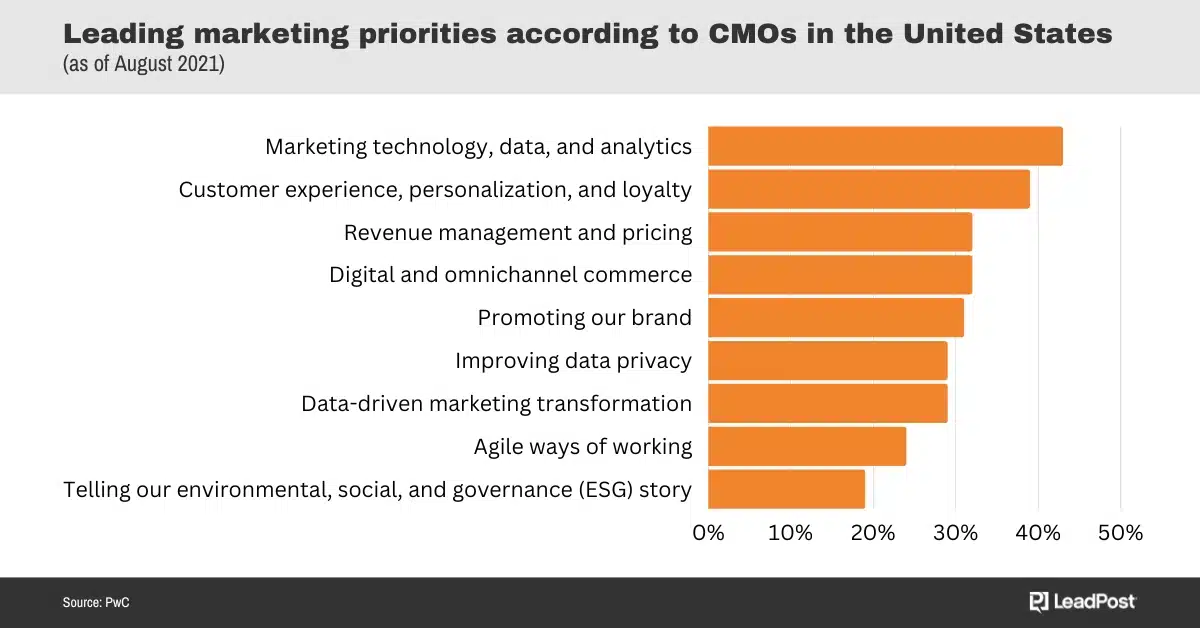Lead generation is a crucial component of any successful marketing strategy. However, with so many lead generation tools available, it can be hard to determine which one to use.
In this article, we will provide some insights from industry experts. These most effective lead generation tools and what makes them stand out.
Why Use Lead Generation Tools?
Lead generation tools help streamline and automate the lead generation process. Good lead generation tools enable businesses to gather leads more efficiently and effectively.
“The best tool for your company depends on several factors,” Kalra said. “Consider the size of your company, your target audience, and your marketing strategy.”
Kalra recommended that marketers look for the following:
- Automation capabilities
- Customizability
- User-friendliness
- A/B testing
- Integrations
- Reporting
Also, remember that some tools are better for B2C, some are focused on B2B leads, and others work for both. You can get a free trial of each of LeadPost’s tools here:
What Types of Lead Generation Tools Are There?
To make things easier, we’re going to split the myriad lead gen tools into the following twelve categories.
- Landing page builders. These tools help create and design custom landing pages without needing to know how to code.
- Email marketing tools. Email marketing tools make it easier to manage email campaigns. They include features such as list management, email design, and delivery.
- Contact form builders. Contact form builders enable marketers to create and add contact forms to a website. These forms then collect information from visitors.
- Chatbots. Chatbots are AI-powered tools that can engage in conversation with website visitors. They provide visitors with information or lead them through a process.
- Marketing automation tools. Marketing automation platforms that automate and streamline marketing processes. They facilitate lead nurturing, lead scoring, lead distribution, and other marketing activities.
- Social media management tools. These tools help manage your social media presence. Features include scheduling and publishing posts, monitoring mentions and interactions, and analyzing performance.
- Search engine optimization (SEO) tools. These tools help optimize websites for search engines. Features include keyword research, on-page optimization, and link building.
- Pay-per-click (PPC) advertising tools. Ad platforms allow marketers to run and manage paid advertising campaigns more efficiently.
- Content management systems (CMS). These tools allow marketers to create, manage, and publish website content without coding.
- Customer relationship management (CRM) systems. CRMs manage your customer relationships. Features include lead tracking, sales forecasting, and customer service management.
- Data collection tools. These tools collect the data marketers need to make informed decisions. Marketers use this data to assess the success of their campaigns, segment their audiences, and to reach new audiences. Marketers can collect behavioral data, psychographic data, psychographic data, and demographic data.
- Website visitor identification tools. Website visitor identification software captures the contact information of anonymous website visitors.
1. Landing Page Builders
Krittin Kalra, the founder of Writecream, provided some insight into effective landing page builders.
He noted that many of the most commonly used and highly regarded tools include landing page builders. Kalra specifically called out HubSpot, Leadpages, ClickFunnels, Aweber, and MailChimp.
These are full-featured tools that also handle many other aspects of the lead generation process. That includes:
- email marketing
- customer relationship management
- advanced analytics
There are also tools like Unbounce that focus solely on landing pages.
2. Email Marketing
Matthew Ramirez is a serial entrepreneur, investor, and the founder of Rephrasely. He shared his thoughts on lead generation tools.
According to Ramirez, one of the most effective lead generation tools is email marketing.
“It allows businesses to communicate with their audience directly,” Ramirez said. “That way they can build relationships with customers and prospects.”
Email marketing can be used to send out newsletters or create email campaigns that guide customers through the sales funnel.
“It’s a powerful tool when used with email automation,” Ramirez said.
Email marketing tools are typically divided into two categories: inbound and outbound. Outbound tools focus on reaching prospects who have yet to interact with your brand. Inbound tools focus on nurturing relationships with existing leads.
Since inbound is their focus (and they don’t want to hurt email deliverability with spam emails) they generally prohibit the use of their platforms for cold outreach. But both tools have their place, so we’ll cover each of them.
Inbound Email Marketing Tools
Sharon Heather is the Business Development Director at EasyMerchant Limited. She recommends Klaviyo for inbound email marketing. EasyMerchant Limited used Klaviyo to achieve a 35% increase in email open rates and a 20% increase in click-through rates.
This was possible thanks to Klaviyo’s features that allowed the company to:
- segment its email list
- personalize the content
- track engagement metrics
Outbound Email Marketing Tools
For cold email, Jan-Philipp Peters, co-founder and CEO of BitsForDigits, recommended two tools. BitsForDigits relies on Lemlist for cold email marketing.
Lemlist offers three plans. The first plan offers personalized cold email outreach campaigns at scale.
The second plan offers personalization, automated follow-ups, and integrations. (Lemlist with Pipedrive, HubSpot, and Salesforce.) This plan also includes unlimited workflows and emails.
The third plan is “Sales Engagement.” It includes all features of the Email Outreach plan. It also includes:
- automated LinkedIn outreach
- video prospecting
- a LinkedIn chrome extension
- native enrichment integration
- custom landing pages
- native cold call integrations
Additionally, there is an “Outbound Agency” plan available for all three pricing plans. This allows you to manage campaigns for all your clients from one spot. It includes report-only access for your clients.
3. Contact Form Builders
Natalia Brzezinska is the Marketing & Outreach Manager at PhotoAid. PhotoAid is a small company with a few people in its marketing department.
Brzezinska uses Picreel for lead capture and popups.
“Picreel is very easy to use and offers a wide range of ready-to-use templates,” Brzezinska said. “That’s great for a small company like ours, where we don’t have separate specialists to handle this.”
Another advantage Brzezinska highlighted is the various triggers and targeting criteria it offers. That means that Natalia and her team have full control over their activities.
4. Chatbots
If you’re new to chatbots, you may want to start with a free option, like Hubspot. But if you’re looking for something for more advanced, there are plenty of choices. Companies like Olark and Zendesk offer advanced chatbots. These tools use AI to choose the best response.
You could also go with a human-powered option like Tawk.to. Even if you don’t have the manpower to take chat requests, Tawk.to provides agents for a small fee.
5. Marketing Automation
According to Kalra of WriteCream, one of the key features that are important in a lead generation tool is automation capabilities. These tools save time and resources by running campaigns automatically. That way they can focus on other critical aspects of their marketing strategy.
6. Social Media Management
Krupa Trivedi is the marketing manager at On-demand Ninja. She said that Linkedin and Facebook have been very effective for her company.
But she also noted that the choice of a network depends on the purpose of generating leads. Trivedi recommends Facebook and Instagram for industries like clothing, travel, and luxury.
“They offer a wide audience with many options for segmentation,” Trivedi said.
But LinkedIn is perfect for generating leads for IT, customer support, and selling IT software.
7. SEO
If your lead generation strategy relies on organic traffic, SEO tools are a must. Ahrefs is a good tool for discovering what keywords to target and making sure your website is optimized.
The company offers four different subscription plans: Lite, Standard, Advanced, and Enterprise. The Lite plan is a good place to start for most companies. It provides the basics you’ll need to audit and track your site, track keywords, and research keywords.
8. PPC Advertising
Bing Ads and Google Ads each off their own editors for basic management. If you’re looking for something more advanced, Optmyzr is an excellent option. It enables you to develop, monitor, and analyze your PPC campaigns.
You can also use Optmyzr to automate scripts and notifications, all from one central location. It supports integrations for Google Ads, Yahoo Ads, and Bind Ads.
Joe Kevens, Director of Demand Generation at PartnerStack and founder of B2B SaaS Reviews has seen success with review site solutions like Capterra’s PPC ads and LinkedIn’s Campaign Manager.
“[LinkedIn] gives you the ability to target and segment on B2B firmographic, demographic, and behavioural criteria with accurate information that’s kept updated by the target audience,” Kevens said.
9. CMS
WordPress is usually the go-to CMS for small businesses and startups. But you may have a good reason to choose something else. For example, Shopify is specifically designed for eCommerce companies.
10. CRM
Heather said that EasyMerchant Limited uses Salesforce as its CRM. They chose it for its robust capabilities in managing and analyzing customer data.
But Salesforce is one of the more expensive options.
11. Data Collection
Data is one of the top marketing priorities for US-based CMOs, but it can be difficult to acquire the data needed. There are expensive tools like Oracle and BlueKai, but there are also options for smaller businesses and startups.

Babikila Marise Mubili, Public Relations Specialist at Pearl Lemon shared a few recommendations:
- LinkedIn Sales Navigator. “This is LinkedIn’s own prospecting tool, and it works great for gathering leads that are more likely to respond and do business.”
- Zoominfo. “This tool gathers commercial contact details from websites. You can use it to build refined lead lists.”
- Be the Business. This tool helps businesses find and connect with potential customers based on their location and industry. It can be especially helpful for local businesses looking to generate leads in their area.
- Upp. Upp helps educational institutions find and connect with potential students and their families.
- DemeRx. This tool helps healthcare providers find and connect with potential patients.
- Secret Dates. Secret Dates enables event planners to find and connect with potential clients.
- Oasis Living. This tool helps real estate agents find and connect with potential buyers and sellers.
Peters of BitsForDigits relies on whoraised.io. Peters emphasized the importance of targeting the appropriate audience within your industry.
“Understanding how to successfully target the appropriate audience within your industry is crucial,” Peters said. “Then you can see how to optimize your outreach campaigns to achieve business goals.”
He needed to target decision-makers from companies looking to outsource growth.
Whoraised.io provides a monthly lead list of companies that recently raised funding. These companies are more likely to outsource their growth. That makes them a perfect audience for BitsForDigits. And whoraised.io’s CSV format allows marketers to use the data with other tools.
Peters imports data from whoraised.io into Lemlist for cold outreach.
12. Website Visitor Identification Tools
When someone visits your website and doesn’t convert, you can still market to them. It’s common to see retargeting campaigns on channels like display and paid social.
Visitor identification tools enable retargeting via email and direct mail as well.
LeadPost offers B2C and B2B data on your anonymous traffic. It also provides premium demographic data fields. Then, you can automate multichannel retargeting campaigns.
You can deliver these campaigns from LeadPost’s retargeting platform, or export the data. If you export the data, you can import it into any tool or ad network you want. Or you can use one of LeadPost’s integrations to send the data.
With its integrated retargeting platform, you can implement multichannel, drip marketing campaigns. You can deliver these campaigns via:
- paid social
- display
- direct mail
Choose Your Lead Generation Tools Carefully
Lead generation tools play a critical role in the success of any marketing strategy. There are many tools available in the market, so it’s essential to evaluate their features. That way you can choose one that best aligns with your specific needs. Then, you can create and execute targeted campaigns to drive business growth.
